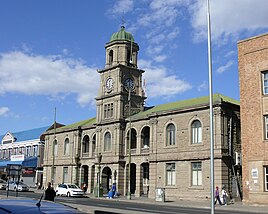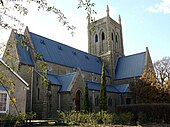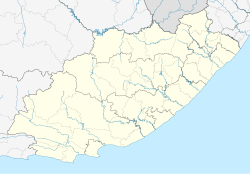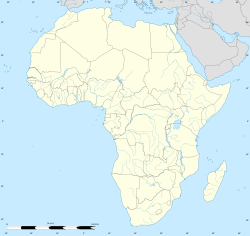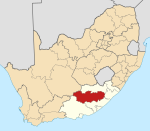Queenstown, South Africa
This article needs additional citations for verification. (December 2022) |
Queenstown
Komani | |
|---|---|
Clockwise from Top: Queenstown City Hall, Dutch Reformed Church, St Michael Anglican Church. | |
| Nickname: Rose Capital of South Africa | |
| Coordinates: 31°54′S 26°53′E / 31.900°S 26.883°E | |
| Country | South Africa |
| Province | Eastern Cape |
| District | Chris Hani |
| Municipality | Enoch Mgijima |
| Established | 1853 |
| Government | |
| • Mayor | Madoda Pipiyana[citation needed] |
| Area | |
• Total | 71.3 km2 (27.5 sq mi) |
| Population (2011)[1] | |
• Total | 68,872 |
| • Density | 970/km2 (2,500/sq mi) |
| Racial makeup (2011) | |
| • Black African | 81.8% |
| • Coloured | 10.0% |
| • Indian/Asian | 1.1% |
| • White | 6.5% |
| • Other | 0.6% |
| First languages (2011) | |
| • Xhosa | 75.2% |
| • Afrikaans | 13.8% |
| • English | 7.3% |
| • Other | 3.7% |
| Time zone | UTC+2 (SAST) |
| Postal code (street) | 5320 |
| PO box | 5319 |
| Area code | 045 |
Queenstown, also known asKomani,[2] is a town in the middle of the Eastern Cape Province of South Africa, roughly halfway between the smaller towns of Cathcart and Sterkstroom on the N6 national route. The town was established in 1853 and is currently the commercial, administrative, and educational centre of the surrounding farming district.
History
[edit]Queenstown was founded in early 1853 under the direction of Sir George Cathcart, who named the settlement, and then fort, after Queen Victoria. Work on its railway connection to East London on the coast was begun by the Cape government of John Molteno in 1876, and the line was officially opened on 19 May 1880.[3]
The town war memorial was designed by Sir Robert Lorimer in 1922 with its sculpture by Alice Meredith Williams.[4]
The town prospered from its founding up to the worldwide depression of the 1930s, and again thereafter. In the 1960s, the majority of the Black population were moved east to the township of Ezibeleni, as part of the attempt to move African people to so-called "homelands".
The area has in the past had very severe weather problems, luckily, often only affecting the surrounding areas. In 2002, heavy snowfall around Queenstown caused a severe disaster, especially since the area was not funded or ready for such a disaster.[5] Then, in 2004, the surrounding areas of the Eastern Cape were affected by strong winds and heavy rainfall,[6] although Queenstown once again escaped much flooding and some wind damage, power shortages soon followed. Other natural disasters include droughts[7] and wildfires.[8]
In February 2016, the government changed the official name for the town from "Queenstown" to "Komani".[2]
Education
[edit]The following high schools serve the town and surrounding areas:
- Hexagon High School
- Queen's College
- Get Ahead Project and College
- Queenstown Girls' High School
- Hoërskool Hangklip
- Royal Academy High School
- Olivet College Private High School
- JJ Serfontein High School
- KwaKomani Comprehensive
- Maria Louw High School
- Nkwanca High School
- Luvuyo Lerumo High School
- John Noah High School
- W.B. Rubusana High School
- Bulelani High School
- Inyathi High School
- Zanabantu High School
- Kopano High School
- Mbekweni High School
- Sixishe Agricultural School
Primary schools in the area include:
- St. Theresa's Primary School
- Hangklip Primary
- Balmoral Girls' Primary School
- Queens College Primary
- Southbourne Primary
- Thembelihle Primary School
- Lukhanji Primary School
- Christ The King
- Louis Rex Primary School
- Olivet College Private School
- Mpendulo Primary School
- Edlelweni Primary School
- Nonesi Primary School
- Van Coller Public Primary School
- Royal Capital Education Centre
Tertiary education institutions in Queenstown include
- Walter Sisulu University
- Ikhala Public FET College
- Boston City Campus and Business College
- Lukhanji FET College
Religion
[edit]The city is the seat of the Roman Catholic Diocese of Queenstown, centred at the Cathedral of Christ the King. It is also the seat of the Anglican Church's Diocese of Ukhahlamba, whose imposing Cathedral Church of St. Michael and All Angels stands adjacent to the town's public gardens.[9] Churches of all faith denominations are to be found in and around the town.
Geography
[edit]The town lies on the Komani River which forms part of the Great Kei system of rivers and has a plentiful water supply from the surrounding rugged mountains. The water is collected in the Bongolo Dam, set in the hills, used extensively for recreation and watersports. Each year, around the beginning of June, the town holds an art exhibition with the emphasis on paintings and sculpture.
Layout
[edit]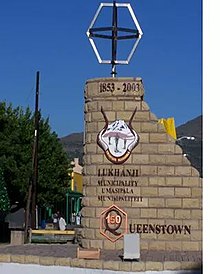
The layout of the town reflects its original objective as a defensive stronghold for the frontier area and has a most unusual design. There is a central hexagonal area where canon or rifle fire could be directed down six thoroughfares radiating from the centre. The canon sites have now been replaced with gardens and a central fountain. An abstract sculpture replaced the fountain as part of the town's 150th anniversary. The hexagon still exists, with the outer road surrounding it named Robinson Road, which encircles it. Surrounding the Hexagon to the east and west lies more commercial and administrative facilities.
Currently, formerly 'white suburbs' (Sandringham, Kingsway, Windsor, Bergsig, Blue rise, Balmoral, Madeira Park and a new suburb of Komani Park) surround the hexagon to the north, east and west, however, one of the city's great townships (and squatter camps) lies to the south. It is a collection of black and coloured townships named Mlungisi, Aloevale, a new township, Victoria Park has been built to the south-east of the city. East of the town lies the much larger Ezibeleni township, which although roughly the same surface area as the main town, has by far a larger population.
Climate
[edit]Queenstown has a cold semi-arid climate (Köppen climate classification: BSk), that borders on a subtropical highland climate (Köppen climate classification: Cfb), and a humid subtropical climate (Köppen climate classification: Cfa).
| Climate data for Queenstown | |||||||||||||
|---|---|---|---|---|---|---|---|---|---|---|---|---|---|
| Month | Jan | Feb | Mar | Apr | May | Jun | Jul | Aug | Sep | Oct | Nov | Dec | Year |
| Record high °C (°F) | 40.6 (105.1) |
40.0 (104.0) |
37.2 (99.0) |
34.0 (93.2) |
31.1 (88.0) |
26.1 (79.0) |
26.4 (79.5) |
31.1 (88.0) |
35.0 (95.0) |
37.8 (100.0) |
38.1 (100.6) |
40.0 (104.0) |
40.6 (105.1) |
| Mean daily maximum °C (°F) | 29.3 (84.7) |
28.7 (83.7) |
27.0 (80.6) |
23.9 (75.0) |
20.6 (69.1) |
18.3 (64.9) |
18.2 (64.8) |
20.2 (68.4) |
22.9 (73.2) |
24.7 (76.5) |
26.4 (79.5) |
28.6 (83.5) |
24.2 (75.6) |
| Daily mean °C (°F) | 21.9 (71.4) |
21.7 (71.1) |
20.1 (68.2) |
16.6 (61.9) |
13.3 (55.9) |
10.6 (51.1) |
10.6 (51.1) |
12.4 (54.3) |
15.1 (59.2) |
17.1 (62.8) |
19.0 (66.2) |
21.1 (70.0) |
16.7 (62.1) |
| Mean daily minimum °C (°F) | 14.5 (58.1) |
14.7 (58.5) |
13.3 (55.9) |
9.4 (48.9) |
6.0 (42.8) |
3.0 (37.4) |
2.9 (37.2) |
4.6 (40.3) |
7.3 (45.1) |
9.5 (49.1) |
11.6 (52.9) |
13.5 (56.3) |
9.2 (48.6) |
| Record low °C (°F) | 3.9 (39.0) |
3.9 (39.0) |
1.5 (34.7) |
−1.1 (30.0) |
−5.5 (22.1) |
−6.7 (19.9) |
−7.5 (18.5) |
−6.7 (19.9) |
−3.8 (25.2) |
−1.7 (28.9) |
0.1 (32.2) |
3.0 (37.4) |
−7.5 (18.5) |
| Average precipitation mm (inches) | 77 (3.0) |
88 (3.5) |
83 (3.3) |
40 (1.6) |
24 (0.9) |
14 (0.6) |
13 (0.5) |
16 (0.6) |
26 (1.0) |
40 (1.6) |
58 (2.3) |
72 (2.8) |
551 (21.7) |
| Average precipitation days (≥ 0.1 mm) | 10.6 | 11.0 | 11.0 | 7.3 | 5.4 | 3.0 | 3.0 | 3.6 | 4.5 | 8.2 | 8.6 | 9.0 | 85.2 |
| Average relative humidity (%) | 64 | 68 | 68 | 66 | 62 | 58 | 54 | 52 | 56 | 61 | 64 | 62 | 61 |
| Source: Deutscher Wetterdienst[10] | |||||||||||||
Geology
[edit]The Queenstown area is in the Burgersdorp Formation of the Tarkastad subgroup, in the upper Beaufort Group Triassic in age in the karoo supergroup. The lithology is red mudstone 1 to 10 m rich layers and sub-ordinate 1 to 2 m rich sandstone layers deposited by meandering rivers in the flood plain in an oxidising environment gradually filling the Karoo basin. The formation reaches a thickness of 600 m in the Komani (Queenstown) and Lady Frere area. Numerous dolerite dykes and ring structures intruded the area creating localities for groundwater exploration.
Media
[edit]The town has two newspapers, The Representative and The Express. It has a community radio station, Lukhanji FM. The Eastern Cape newspaper, Daily Dispatch, is widely read in the area.
Coats of arms
[edit]The Queenstown municipal council assumed a pseudo-heraldic coat of arms in October 1902.[11] The shield was quartered and depicted the Union Jack, a landscape with Hangklip mountain in the background, a landscape with a mimosa tree in the foreground, and a portrait of King Edward VII. The crest was a demi-antelope, and the motto Unity is strength.[12] The council later assumed a new coat of arms. The new shield displayed a golden royal coronet on a red background. The crest was the same as before, but the motto was translated into Latin as Ex unitate vires.[13]
Notable people
[edit]Queenstown has produced 2 Olympians and a plethora of musicians, sportsmen(national and international) and more. Some notable names hailing from the town are:
- Linky Boshoff
- Lionel Cronje
- Daryll Cullinan
- Carlo Del Fava
- Allan Dell
- S'bura Sithole
- Glen Dell
- Mongezi Feza
- Ian Greig
- Tony Greig
- Justin Kemp
- Robbi Kempson
- Rayne Kruger (1922-2002) — author
- Kaya Malotana
- Ken McEwan
- Pat Matshikiza[14]
- Todd Matshikiza
- Stompie Mavi
- Lwazi Mvovo
- Don Pinnock
- Olive Schreiner
- Margaret Singana
- Minah Soga[15]
- Jomo Sono
- Stratford Edward St Leger
- Marius Corbett
- Yaw Penxe
- Simphiwe Matanzima
- Jimmy White
- Roelof Smit
- John Frost
- Rabz Maxwane
- Pat Spence
- Rocco Jansen
- Rex Witte
- Isaac Bangani Tabata
- Andisa Ntsila
- Elaine Bellew-Bryan, Baroness Bellew
- David Roos
- Dave Callaghan
- Delarey du Preez
- Ken Austin (cricketer)
- Harry Schmidt (pentathlete)
- George Patching
References
[edit]- ^ a b c d Sum of the Main Places Queenstown and Mlungisi from Census 2011.
- ^ a b "Government Gazette No. 39669" (PDF). South African Government. 9 February 2016. p. 9. Archived from the original (PDF) on 7 February 2017. Retrieved 11 October 2018.
- ^ Burman, Jose (1984). Early railways at the Cape. Human & Rousseau. p. 86. ISBN 9780798117609.
- ^ Basic biographical details of Sir Robert Stodart Lorimer at the Dictionary of Scottish Architects Biographical Database.
- ^ Raasch, Sonja (22 July 2002). "Snow rescue teams bring relief". Archived from the original on 1 September 2003.
- ^ Prince, Chandré (27 September 2004). "Weekend weather batters Eastern Cape". Archived from the original on 8 November 2004.
- ^ "Water drying up in north-eastern Cape". 30 August 1999. Archived from the original on 21 October 2012.
- ^ Raasch, Sonja (31 August 1999). "Stofile demands facts on veld fire damage". Archived from the original on 12 May 2006.
- ^ Menache, Philippe; David, Darryl Earl (2015). Church Tourism in South Africa: A Travel Odyssey : Also Featuring, On Tour with Wynand Louw. Menache and David (Self published). p. 28. ISBN 978-0-620-67799-8.
- ^ "Klimatafel von Queenstown, Prov. Eastern Cape / Südafrika" (PDF). Baseline climate means (1961–1990) from stations all over the world (in German). Deutscher Wetterdienst. Retrieved 19 November 2016.
- ^ Western Cape Archives: Queenstown Municipal Minutes (29 October 1902).
- ^ The arms were depicted on a cigarette card issued in 1931.
- ^ The arms are illustrated (in black and white) in the Official South African Municipal Yearbook (1983).
- ^ "Patrick Vuyo Matshikiza". sahistory.org.za.
- ^ "THE FORMAL FORMATION OF THE NCAW". National Council of African Women.

